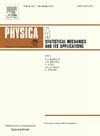Attention-based CNN model for motor imagery classification from nonlinear EEG signals
IF 2.8
3区 物理与天体物理
Q2 PHYSICS, MULTIDISCIPLINARY
Physica A: Statistical Mechanics and its Applications
Pub Date : 2024-11-01
DOI:10.1016/j.physa.2024.130191
引用次数: 0
Abstract
Motor imagery (MI)-based brain–computer interface (BCI) provides a promising solution for the limb rehabilitation of stroke patients. For better rehabilitation performance, high-precision classification of MI-related EEG signals plays a critical role. However, this is still a challenging problem for multi-category MI signals. In this paper, we focus on four commonly used stroke rehabilitation actions, and propose a modular temporal–spatial attention-based CNN (MTSACNN) model for MI classification. In detail, we carry out the MI experiments and acquire the EEG signals related to imagining left/right fist clenching and left/right wrist dorsiflexion. MTSACNN model firstly extracts the low-order MI features through the temporal–spatial feature extraction module (TSFE module). Especially, a group attention mechanism is proposed for intra-group information interaction. Secondly, considering the short- and long-term working characteristics of brain, high-order temporal features are further extracted and fused by the multi-level feature fusion module (MLFF module). Finally, four auxiliary losses are arranged in the classification module (C module) to speed up the model optimization process. The experimental results show that MTSACNN model can achieve good performance in decoding rehabilitation-related MI brain intentions, achieving an average classification accuracy of 72.05% for fourteen subjects. This work is beneficial to promote the construction of high-performance stroke rehabilitation BCI system.
基于注意力的 CNN 模型,用于从非线性脑电信号中进行运动图像分类
基于运动想象(MI)的脑机接口(BCI)为中风患者的肢体康复提供了一种前景广阔的解决方案。为了获得更好的康复效果,对与运动意象相关的脑电信号进行高精度分类起着至关重要的作用。然而,对于多类别 MI 信号来说,这仍然是一个具有挑战性的问题。本文重点研究了四种常用的脑卒中康复动作,并提出了一种用于 MI 分类的基于时空注意力的模块化 CNN(MTSACNN)模型。具体来说,我们进行了脑干损伤实验,并获取了与想象左/右握拳和左/右手腕外展相关的脑电信号。MTSACNN 模型首先通过时空特征提取模块(TSFE 模块)提取低阶 MI 特征。特别是针对组内信息交互提出了群体注意机制。其次,考虑到大脑的短期和长期工作特性,通过多级特征融合模块(MLFF 模块)进一步提取和融合高阶时空特征。最后,在分类模块(C 模块)中安排了四个辅助损失,以加快模型优化过程。实验结果表明,MTSACNN 模型在解码康复相关的 MI 脑意向方面表现良好,14 名受试者的平均分类准确率达到 72.05%。这项工作有利于推动高性能脑卒中康复BCI系统的建设。
本文章由计算机程序翻译,如有差异,请以英文原文为准。
求助全文
约1分钟内获得全文
求助全文
来源期刊
CiteScore
7.20
自引率
9.10%
发文量
852
审稿时长
6.6 months
期刊介绍:
Physica A: Statistical Mechanics and its Applications
Recognized by the European Physical Society
Physica A publishes research in the field of statistical mechanics and its applications.
Statistical mechanics sets out to explain the behaviour of macroscopic systems by studying the statistical properties of their microscopic constituents.
Applications of the techniques of statistical mechanics are widespread, and include: applications to physical systems such as solids, liquids and gases; applications to chemical and biological systems (colloids, interfaces, complex fluids, polymers and biopolymers, cell physics); and other interdisciplinary applications to for instance biological, economical and sociological systems.

 求助内容:
求助内容: 应助结果提醒方式:
应助结果提醒方式:


